|
The Hellenic Genocide
Quotes from historical documents and related Photos. |
|||
CHAPTER XIX: "The story has frequently been told by Americans and others who were at Smyrna that a crowd of residents, men, women and children, had gathered on a lighter lying in the harbor but a short distance from the pier, with the hope that some Entente or American launch would tow them to a ship and save them. The Turks threw petroleum on them and burned them all to death. A confirmation of this dreadful story was furnished me by Miss Emily McCallam, directress of the Intercollegiate Institute of Smyrna. She arrived in that ill-fated city on the morning of September 14, 1922, after the fire set by the Turks had been raging all night, and saw a number of charred bodies floating in the harbor, which she was informed were the corpses of the people cremated on the lighter." CHAPTER XIX: "A prominent Dutch merchant of Smyrna, who had taken refuge on his yacht during the fire, related to me at Athens that all through the night of the dreadful thirteenth he heard fearful screams from the shore, ending suddenly in a queer watery gurgle. He learned the next morning that a lot of throats had been cut." CHAPTER XIX: "There are horrible tales told of the burning of the sick in the hospitals and of children in the schools. The pupils in the American schools and institutions were practically all saved, as also the orphans entrusted to our care." CHAPTER XIX: "There is no doubt, however, that many Greek children, attendants of the schools in the center of the burned area, perished in the flames, and that numerous sick lost their lives in the same way. What the number was can not be determined, but in view of the rapidity of the spread of the fire, any safe evacuation of the hospitals was evidently impossible." CHAPTER XIX: "Wholesale violation of women and girls was one of the outstanding features of the Smyrna horror. It is necessary to mention this disgusting subject, though not to dwell upon it; it can not be possible that the Christian people of America for material advantages will be in sympathy with a policy of coddling a race that specializes in such conduct. " CHAPTER XIX: "On this point a letter is submitted by Doctor M. C. Elliott, a noted and native-born American physician who for several years was engaged in hospital work in the Near East. Doctor Elliott’s testimony that she has never yet seen a Mussulman woman who had been violated is significant and, incidentally, is high tribute to the Greek soldier. It will be seen, also, that Turks confine their lustful orgies to Christian girls." CHAPTER XIX: "My position as a woman physician makes me peculiarly well placed to know about the treatment of young girls by the Turks. In my four-year experience in Turkey I think it is a rather remarkable fact that I have yet to see the Turkish girl or woman who has been ravished. As a marked contrast to this I have seen hundreds of Christian girls who have been in the hands of Turkish men. The late Smyrna disaster was no exception to this and I can justly come to the conclusion from what I have seen with my own eyes that the ravishing of Christian girls by Turks in Smyrna was wholesale. I have actually examined dozens of such girls and have had the story from them of the experiences of other girls with them. By actual examination I have proven that their story in regard to this was not exaggeration, so I have no reason to believe the statement they made in regard to their companions was not true." CHAPTER XIX: "Among other witnesses of the Smyrna outrage was an employee of the great firm of MacAndrews and Forbes, of New York. Their offices at Smyrna were in the fire-devastated area. This man saw Turks throwing hand-grenades into buildings, which later caught fire." CHAPTER XIX: "A prominent Y. M. C. A. official, a native-born American, related to me the following: "I was standing with several others on the deck of a ship, watching the fire, when I saw some persons throwing some liquid against one of the large buildings directly on the sea, and very soon the building burst into bright flames. Turkish soldiers were patrolling up and down in front of the building at the time and did not interfere."" CHAPTER XIX: "A well-known Y. M. C. A. worker informed me at Athens that he saw women stabbed with bayonets by Turks and the bodies of children who had been thus stabbed. His progress through the town in an automobile while on errands of mercy, was impeded by corpses." The Hellenic Genocide Quotes from historical documents and related Photos. Previous page | Initial page | Site Map | Next page (24th of 29) |
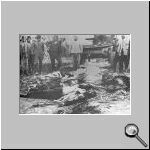
Turks seem to rejoice watching a massacred Christian family.
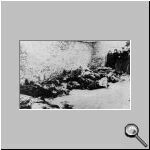
Armenian families see their murdered relatives.

The Archbishop Chrysostomus. He was tortured and killed.
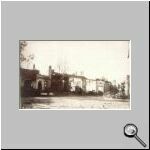
The Bella Vista in Smyrna. Burnt.

A destroyed village in Smyrna.
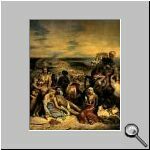
Massacre at Chios, painted by Eugène Delacroix in 1824.
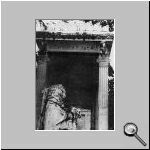
Decapitated statue in the desecrated cemetery of Sisli.
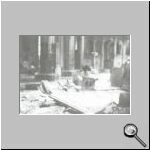
The interior of a destroyed church in Constantinople.
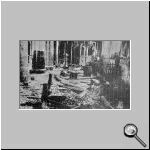
The right wing of the church of Zoodochos.
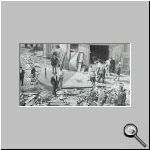
Consternation and destruction in Constantinople.